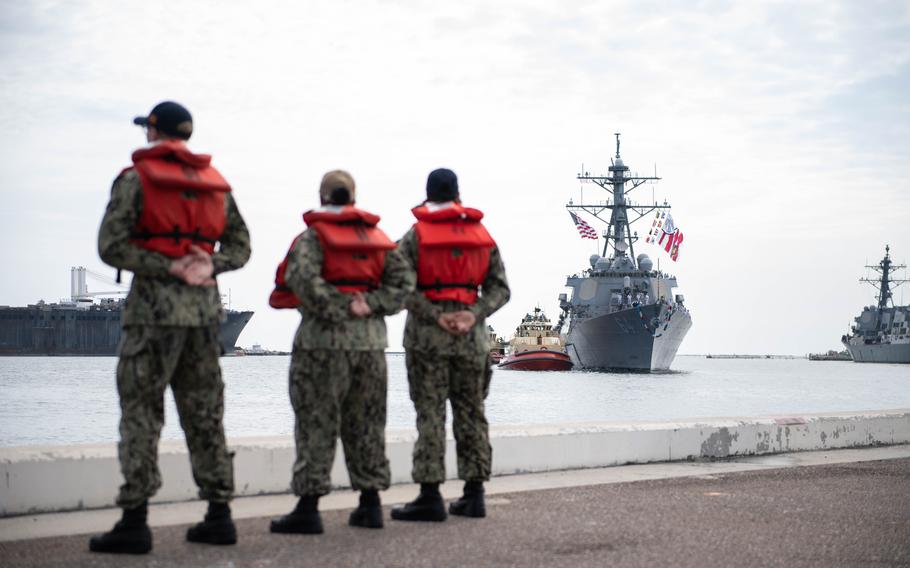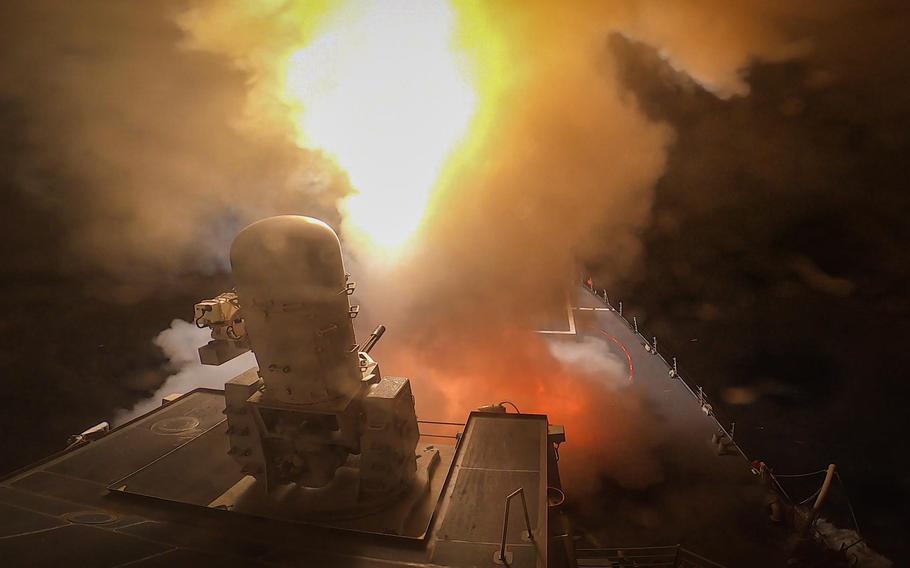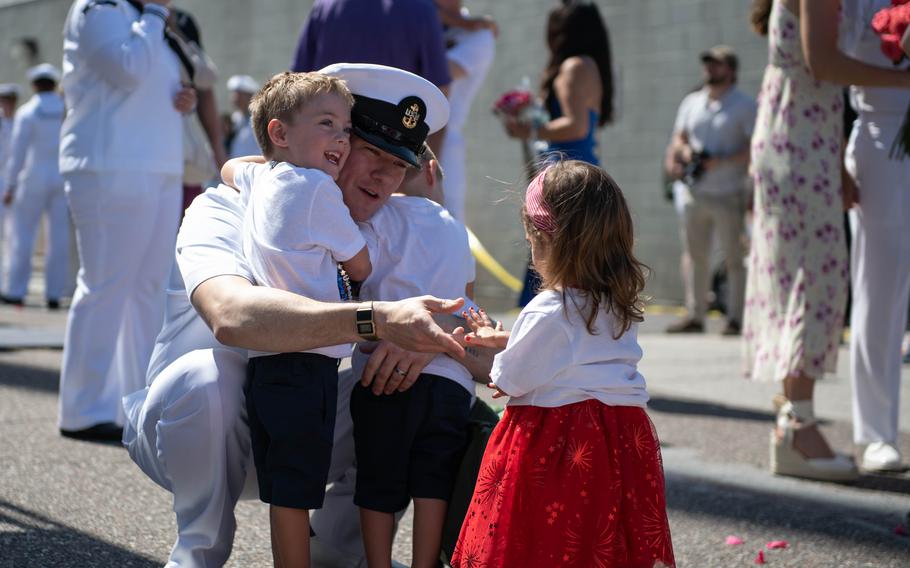
USS Carney prepares to moor pier-side May 19, 2024, during a homecoming event at Naval Station Mayport, Fla., after a deployment in the Red Sea. (Sophie A. Pinkham/U.S. Navy)
The USS Carney guided-missile destroyer had just transited the Suez Canal from the Mediterranean Sea into the Red Sea when Houthi militants in Yemen launched a surprise attack Oct. 19, sending missiles and drones flying toward Israel.
The sudden barrage was launched in the wake of Israel’s war on Hamas in Palestinian-controlled Gaza in retaliation for the group’s Oct. 7 terrorist attack on Israeli civilians. The Carney, sailing alone in the northern Red Sea, sprang to action, shooting down at least four cruise missiles and more than a dozen drones in an engagement that foreshadowed the remainder of the destroyer’s deployment. The ship would spend months countering drone and missile attacks on vessels in the Red Sea by the Iran-backed Houthis.
“None of us could have prepared for this. None of us could have known what was going to happen,” Cmdr. Jeremy Robertson, the Carney’s commanding officer, said Monday, one day after the ship’s return to its homeport at Naval Station Mayport near Jacksonville, Fla. “We never had anyone who shied away from the moment. … They were just in the moment, and it was amazing to see how quickly they transition into a battle mindset.”
Carney deployed from Mayport on Sept. 27, joining the USS Gerald R. Ford Carrier Strike Group in the Eastern Mediterranean briefly before it moved into the Red Sea on Oct. 18. After the Houthis launched the attack on Israel one day later, the Carney would spend the rest of its seven-month deployment on a war footing, constantly prepared to shoot down enemy munitions.

The Arleigh Burke-class, guided-missile destroyer USS Carney fires at Houthi missiles and drones in the Red Sea on Oct. 19, 2023. (Aaron Lau/U.S. Navy)
Robertson said there was “no typical day” for the ship’s 350-some crew members once they entered the Red Sea. On most ship deployments, he said, crews tend to establish normal rhythms as they go about operating the ship, training and carrying out their duties. But the Houthis kept the Carney’s crew on its toes, he said.
“Every day was completely different from one another,” the commander said. “Some days you got no activity, some days you had activity where there would be a [Houthi] launch and nothing would actually make it into the Red Sea. And then some days there [was a lot of] of activity — like Oct. 19, when we had 19 threats.”
By the end of the Carney’s deployment, the ship had conducted some 51 engagements against Houthi weapons, shooting down land-attack cruise missiles and anti-ship ballistic missiles and drones, according to the Navy. It also conducted two defensive strikes that destroyed 20 Houthi targets in Yemen. The service said Carney was also involved in shooting down Iranian ballistic missiles fired at Israel on April 13, when Iran launched hundreds of drones and missiles at Israel in retaliation for an attack that killed senior commanders of its Islamic Revolutionary Guard Corps.
The ship on Sunday was awarded the Navy Unit Commendation — the service’s second-highest unit award — for distinguishing “itself by outstanding heroism in action against enemy forces,” the Navy said.
Robertson said he was routinely awed by his sailors’ work aboard the destroyer in an operating environment that has been described by several top Navy officials as the most volatile for Navy ships since World War II.
After the initial Houthi attack, Robertson said he could sense some “nervousness and anxiety” aboard the ship. But with every engagement with Houthi rebels, his sailors became more confident in their abilities and the capabilities of their weapons.
“We were doing everything we could to make sure that we didn’t make a mistake,” Robertson said of the first few engagements. “But they were very excited to be doing their job, and it was really fun to watch the team do their jobs. I was very proud of them, and I could not have asked for a better response, could not have asked for a better situation for them to prove to themselves that they could handle this and rise to the occasion.”

Navy Chief Operations Specialist Noah Wicks greets his children May 19, 2024, after returning home to Naval Station Mayport, Fla., after a deployment in the Middle East. (Sophie A. Pinkham/U.S. Navy)
At times, the Carney’s crew had only seconds to respond to a Houthi attack. Anti-ship ballistic missiles, he said, must be shot down within nine to 20 seconds of their launch, proving “very challenging.”
“It’s very dynamic, and it’s very fast,” Robertson said. “I have to have 100% confidence in my [tactical action officers], and all of the watch teams, and all of the systems that we have that are designed to detect” anti-ship ballistic missiles.
Those systems and sailors performed as they should, he said.
The commander said he largely credited the Navy’s training programs with properly preparing his troops to fight in the Red Sea.
He said he would not have changed the pre-deployment training that the ship’s crew underwent in the months before it set sail for the Mediterranean Sea even if he knew the dangerous mission it would eventually face.
The only change that he would perhaps make was to add something completely unexpected during training “to keep them on their toes” because the ship’s crew found itself faced with the unexpected repeatedly in the fight with the Houthis.
Robertson said the Carney deployment would remain at the forefront of his Navy memories, and he would take lessons learned from the fight with the Houthis into his future service, including at his next assignment at the Naval Surface and Mine Warfare Development Center in San Diego.
“The crew was there for each other, they got through it together, built resiliency together. Their cohesion and connectedness (are) … why they made such an effective warfighting team,” Robertson said. “It was amazing to see the team transition to that battle mindset and watch their responsibilities and actions … become instinctual and second nature — better, smarter, faster every day.
“I promise you this they’ll never forget this for the rest of their lives.”